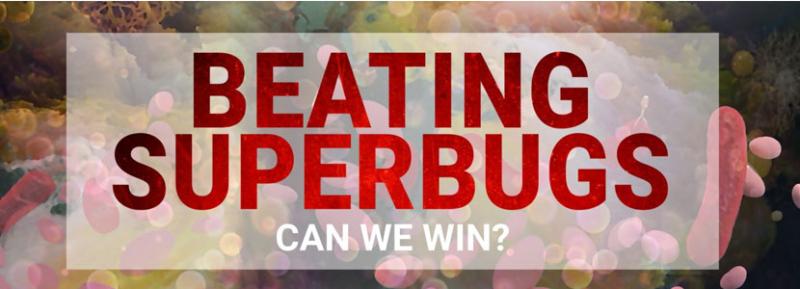5-Questions: Bill Mudge, Recombinant Films
1. Can you tell us about Recombinant Films and why you chose to do a documentary on antibiotic resistance?
I first started reading about antibiotic-resistant bacteria, superbugs, more than 10 years ago and realized that the same stories were emerging again and again: People were dying of untreatable bacterial infections in various parts of the world without much notice. Doctors and researchers knew something far more ominous was happening: Many kinds of bacteria were becoming resistant to the antibiotics we had taken for granted since World War II. The general public was only vaguely aware of the dangers, never mind any real fixes. I saw a need to bring these story fragments together and highlight the best scientific, economic, and political solutions available. I felt strongly that people around the world must recognize antibiotic resistance threats and how to fight them. A film seemed like the most effective way to focus their attention on these issues.
Of course, once you get serious about making a film you need to create a company to support the whole effort. That turned out to be Recombinant Films, with an eye towards making a whole range of science-oriented documentaries over time. There were and still are just three of us, writer Jean Mudge, key science advisor Bob Milley, and myself--director, editor, and animator.
2. Your documentary is very comprehensive. How long did you research the issue and how did you go about that process?
If you had told us around 2013 how long it would take to read thousands of articles about antibiotic resistance and line up some of the key people behind the science, economics, and politics involved we never would have believed you. At first, we just wrote to leaders in the field, hoping that they would share an interest in what we were doing, especially how we emphasized solutions. We already had one good patient story on film with Grant Hill from an earlier project but we needed much more. We ultimately filmed people in 5 different countries. We did not wait; once someone agreed to participate we got footage relatively quickly. We chose our resistance survivors among successful people including a college student, professional athlete, cartographer and university professors to underscore that if people like them can get a life-threatening antibiotic resistant infection then anyone can. As one of our experts, John Rex, points out, the assumption that these problems always happen “over there” somewhere else ... is really wrong.” The threats are not just “on the doorstep.” The dangers of antibiotic resistance “came inside” years ago.
Our story really came together during a 2018 interview with Lord Jim O’Neill, a global economist, who shared his now widely-accepted plan to help pay for new antibiotic developments. Rather than just talk about how governments, universities, and big pharmaceutical companies should collaborate, his report has come up with a viable way to help new discoveries reach the marketplace, but only as needed. Solutions to antibiotic resistance become real only with the right economic and political support. Otherwise, they’re only laboratory curiosities instead of vital public health initiatives.
3. What did you learn that surprised you most about the issue of antibiotic resistance?
We were especially surprised at how effective some older cures like faecal matter transplants and phage therapy still are in the whole arsenal of medical science. Conventional wisdom says that “breakthrough” cures are always new. Of course, that’s not to diminish some of the latest contributions like the new Halicin antibiotic, the AI-based processes that made it possible, or the CRISPR gene editing techniques that add incredible value to the worldwide efforts to contain superbugs. Another surprising finding is how diverse and ingenious mechanisms of resistance are across a wide range of bacterial species.
4. What do you think the most important takeaway is for viewers? How can our readers watch the documentary?
Simple hand-washing and basic sanitation avoid the need for antibiotics in the first place. Also, read labels to avoid antibiotics in the products you buy like soaps, toothpaste, and meats. Be prepared to accept your doctor’s judgment that you don’t need antibiotics for viral illnesses like the flu or the common cold. If your doctor prescribes antibiotics, be sure to follow all the directions so they’ll work well. Finally, vote for candidates who understand science and how much it costs. Public support will allow governments, universities, and pharmaceutical companies to coordinate public health programs and research. It takes a global effort and billions of dollars to move new antibiotics from initial discovery to the pharmacy shelf. Last week, our film was days away from coming out on Amazon Prime Video. Unfortunately, Amazon has just changed their policy so that they now reject unsolicited documentaries like ours, as well as short films. We are now exploring other streaming platform options and will advise everyone as soon as we know when and where the film will appear.
5. After making this documentary, what freaks out the most? What gives you hope?
What’s scary: We’re still close to a tipping point of losing control of antibiotic drug resistance. The natural evolution driving resistance, massively accelerated by human behavior, won’t wait for the politics, economic agreements, and personal choices needed to keep it at bay.
What’s great: The emerging science, on the other hand, is nothing less than amazing. That said, we must also usher the best of these discoveries from the lab to the pharmacy as quickly as possible. In short, there’s no practical reason to accept defeat at the hands of superbugs if we “get our act together” in a range of ways we explore in “Beating Superbugs: Can We Win?”


